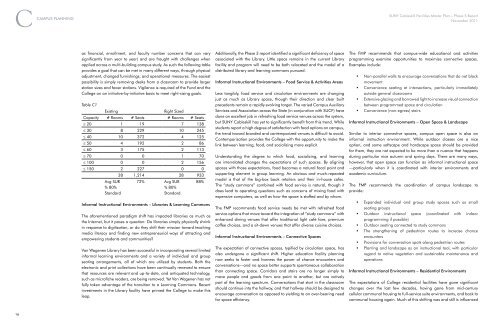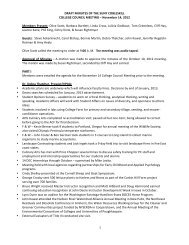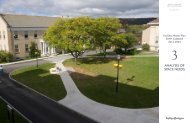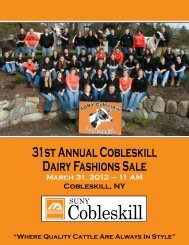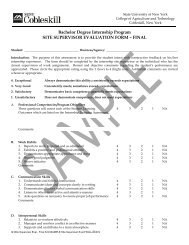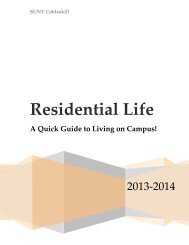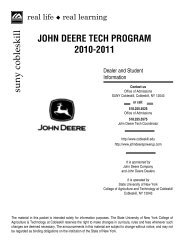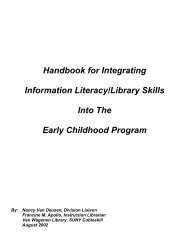Part 5: Final Recommendation - SUNY Cobleskill
Part 5: Final Recommendation - SUNY Cobleskill
Part 5: Final Recommendation - SUNY Cobleskill
You also want an ePaper? Increase the reach of your titles
YUMPU automatically turns print PDFs into web optimized ePapers that Google loves.
C<br />
CAMPUS<br />
PLANNING<br />
<strong>SUNY</strong> <strong>Cobleskill</strong> Facilities Master Plan – Phase 5 Report<br />
November 2011<br />
as financial, enrollment, and faculty number concerns that can vary<br />
significantly from year to year) and are fraught with challenges when<br />
applied across a multi-building campus study. As such the following table<br />
provides a goal that can be met in many different ways, through physical<br />
adjustment, changed furnishings, and operational measures. The easiest<br />
possibility is simply removing desks from a classroom to provide larger<br />
station sizes and fewer stations. Vigilance is required of the Fund and the<br />
College on an initiative-by-initiative basis to meet right-sizing goals.<br />
Table C1<br />
Existing<br />
Right Sized<br />
Capacity # Rooms # Seats # Rooms # Seats<br />
≤ 20 1 19 7 138<br />
≤ 30 8 229 10 245<br />
≤ 40 10 372 4 125<br />
≤ 50 4 192 2 86<br />
≤ 60 3 175 2 113<br />
≤ 70 0 0 1 70<br />
≤ 100 0 0 2 156<br />
≤ 150 2 227 0 0<br />
Avg SUR<br />
% 80%<br />
Standard<br />
28 1,214 28 933<br />
72% Avg SUR<br />
% 80%<br />
Standard<br />
88%<br />
Informal Instructional Environments – Libraries & Learning Commons<br />
The aforementioned paradigm shift has impacted libraries as much as<br />
the Internet, but it poses a question: Do libraries simply physically shrink<br />
in response to digitization, or do they shift their mission toward teaching<br />
media literacy and finding new entrepreneurial ways of attracting and<br />
empowering students and communities?<br />
Van Wagenen Library has been successful in incorporating several limited<br />
informal learning environments and a variety of individual and group<br />
seating arrangements, all of which are utilized by students. Both the<br />
electronic and print collections have been continually renewed to ensure<br />
that resources are relevant and up-to-date, and antiquated technology,<br />
such as microfiche readers, are being removed. Yet Van Wagenen has not<br />
fully taken advantage of the transition to a Learning Commons. Recent<br />
investments in the Library facility have primed the College to make this<br />
leap.<br />
Additionally, the Phase 3 report identified a significant deficiency of space<br />
associated with the Library. Little space remains in the current Library<br />
facility and program will need to be both relocated and the model of a<br />
distributed library and learning commons pursued.<br />
Informal Instructional Environments – Food Service & Activities Areas<br />
Less tangibly, food service and circulation environments are changing<br />
just as much as Library space, though their direction and clear built<br />
precedents remain a rapidly evolving target. The varied Campus Auxiliary<br />
Services and Association across the State (in conjunction with SUCF) have<br />
done an excellent job in refreshing food service venues across the system,<br />
but <strong>SUNY</strong> <strong>Cobleskill</strong> has yet to significantly benefit from this trend. While<br />
students report a high degree of satisfaction with food options on campus,<br />
the trend toward branded and contemporized venues is difficult to avoid.<br />
Contemporization provides the College with the opportunity to make the<br />
link between learning, food, and socializing more explicit.<br />
Understanding the degree to which food, socializing, and learning<br />
are interrelated changes the expectations of such spaces. By aligning<br />
spaces with those expectations, food becomes a natural focal point and<br />
supporting element in group learning. An obvious and much-repeated<br />
model is that of the big-box book retailers and their in-house cafes.<br />
The “study commons” combined with food service is natural, though it<br />
does lead to operating questions such as concerns of mixing food with<br />
expensive computers, as well as how the space is staffed and by whom.<br />
The FMP recommends food service needs be met with refreshed food<br />
service options that move toward the integration of “study commons” with<br />
enhanced dining venues that offer traditional light café fare, premium<br />
coffee choices, and a sit-down venues that offer diverse cuisine choices.<br />
Informal Instructional Environments – Connective Spaces<br />
The expectation of connective spaces, typified by circulation space, has<br />
also undergone a significant shift. Higher education facility planning<br />
now seeks to foster and harness the power of chance encounters and<br />
conversations—and no space better supports spontaneous collaboration<br />
than connecting space. Corridors and stairs are no longer simply to<br />
move people and goods from one point to another, but are actively<br />
part of the learning spectrum. Conversations that start in the classroom<br />
should continue into the hallway, and that hallway should be designed to<br />
encourage conversation as opposed to yielding to an over-bearing need<br />
for space efficiency.<br />
The FMP recommends that campus-wide educational and activities<br />
programming examine opportunities to maximize connective spaces.<br />
Examples include:<br />
•<br />
•<br />
•<br />
•<br />
Non-parallel walls to encourage conversations that do not block<br />
movement<br />
Convenience seating at intersections, particularly immediately<br />
outside general classrooms<br />
Extensive glazing and borrowed light to increase visual connection<br />
between programmed space and circulation<br />
Convenience (non-egress) stairs<br />
Informal Instructional Environments – Open Space & Landscape<br />
Similar to interior connective spaces, campus open space is also an<br />
informal instruction environment. While outdoor classes are a nice<br />
option, and some softscape and hardscape space should be provided<br />
for them, they are not expected to be more than a nuance that happens<br />
during particular nice autumn and spring days. There are many ways,<br />
however, that open space can function as informal instructional space<br />
—particularly when it is coordinated with interior environments and<br />
academic curriculum.<br />
The FMP recommends the coordination of campus landscape to<br />
provide:<br />
•<br />
•<br />
•<br />
•<br />
•<br />
•<br />
Expanded individual and group study spaces such as small<br />
seating groups<br />
Outdoor instructional space (coordinated with indoor<br />
programming if possible)<br />
Outdoor seating connected to study commons<br />
The strengthening of pedestrian routes to increase chance<br />
encounters<br />
Provisions for conversation spots along pedestrian routes<br />
Planting and landscape as an instructional tool, with particular<br />
regard to native vegetation and sustainable maintenance and<br />
operations<br />
Informal Instructional Environments – Residential Environments<br />
The expectations of College residential facilities have gone significant<br />
changes over the last few decades, having gone from mid-century<br />
cellular communal housing to full-service suite environments, and back to<br />
communal housing again. Much of this shifting was and still is influenced<br />
16


